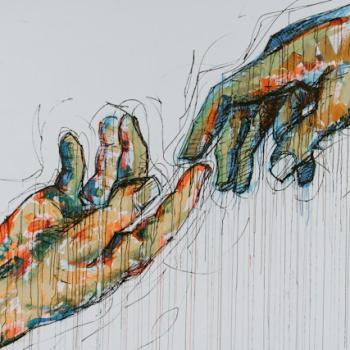
My husband, a former engineer, used to joke that he could no longer do basic arithmetic because he had gotten so used to solving equations with Greek letters and squiggly lines. As much as I have enjoyed learning about the work of Einstein and Schrödinger and Heisenberg in recent years, I still tremble at the sight of the Greek letters and squiggly lines. I can hang in there with Einstein on relativity: e=mc2. But I’m a lost cause when it comes to his field equations:

Say what? I like my formulas clean and simple. A few that make perfect sense to me are . . .
Teenage Son + Missed Curfew = No Xbox.
Could Have Been an Email (Eye Roll + Deep Sigh) = Weekly Staff Meeting
Fern = Useless Cute Boy’s Lecture Notes / 16 Lousy Points
Clean and Simple.
I think that’s why I love today’s Gospel reading. It tells the story of Jesus visiting Simon’s house where his mother-in-law was sick with a fever. There’s a clean and simple formula Jesus uses return her to health: “He approached, grasped her hand, and helped her up” (Mark 1:31). Fully restored, she hopped up and started serving the tea and cookies.
Yesterday I wrote about how both science and religion point us to the truth that we all come from the same source. We forget this original wholeness and unity though in favor of the worst form of “alternate facts,” the deceptively alluring belief that we are separate – from each other, the earth around us, all of life. But there is a way back our sacred origin, and Jesus gives us a nifty formula for doing just that.
He Approached
The word “approach” comes from the Latin appropiare which means to “draw near.” The first step, then, in getting back to our factory setting is to draw near to that which we have previously understood as “other.” Pope Francis is fond of using the word, “encounter,” to describe this desire and responsibility we have to draw near.
As reported in L’Osservatore Romano, his homily on September 13, 2016 was an “’invitation to work for ‘the culture of encounter,’ in a simple way, ‘as Jesus did:’ not just seeing, but looking; not just hearing, but listening; not just passing people by, but stopping with them; not just saying “what a shame, poor people!”, but allowing yourself to be moved with compassion; ‘and then to draw near, to touch and to say: ‘Do not weep’ and to give at least a drop of life.’”
“An encounter is not what you wait for; it is what you hunt for.”
~ david O. abioye
If wholeness is both our birthright and destiny, then such a ‘culture of encounter’ is simply enlightened self-interest. If you and I are really one, then it only makes sense for me to be concerned for you. Even if I hate everything you stand for. Even if you are cruel and selfish and have hurt me deeply. Even if you are my enemy. Paradoxically, it’s in caring for you that I take care of myself.
He Grasped Her Hand
But as hard as it is to care for those who seem completely “other,” it’s far more challenging to take that first step into real encounter. It’s one thing to see the filthy person by the side of the road holding the cardboard sign that reads, “Homeless and broke.” It’s quite another to stop and ask him how he is, especially if his own poor choices landed him at that spot in that moment with that sign. It’s quite another still to offer him a blanket or a sandwich, especially when he says he’d prefer cash.
But this “grasping,” this skin-on-skin connection with others, is part of Jesus’ formula for restoring us to the holy oneness from which we came. Is it merely coincidence that that the physical acts of “grasping” another in kindness – a shared smile, a warm handshake, a big bear hug – all feel so good? I don’t think so. They feel so good because they get us back to who we really are. It can’t be any accident that sex, the most intense form of physical union, gives us so much pleasure. We are not meant to be separate.
He Helped Her Up
The thing I love about the way Jesus heals Simon’s mother-in-law is the complete lack of special effects. There’s no booming James Earl Jones voice proclaiming victory over death. There are no fireworks set to music, no neon signs, no rabbits in hats, no burning bushes. The miracle happens when Jesus simply “helped her up.”
To me, the message is clear – do something that’s not nothing. I’m not going to cure cancer or eliminate global food insecurity. But I can sit with someone during chemo and donate to a food bank. As Saint Theresa of Calcutta famously said, “Not all of us can do great things. But we can do small things with great love.” Those “small things” are the real miracle because they take us one step closer to the richness of our true selves.
Clean and Simple, Reprise
The formula for remembering who we are and where we came from is clean and simple in this week’s Gospel reading. But as anyone who’s lived on earth more than a couple minutes knows, clean doesn’t mean uncomplicated, and simple doesn’t mean easy. Sometimes it’s crazy-hard to approach her, to grasp her hand, and to help her up. But just as a stupid fern needs water to grow into a 16-point useless absurdity in Biology 102, we need to create a “culture of encounter” in order to get back to who we truly are.











